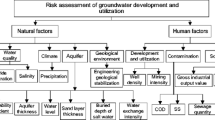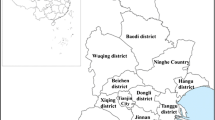Abstract
The risk analysis on karst groundwater pollution is a research hotspot in current international hydrogeological field as well as the premise of preventing and controlling groundwater pollution. According to the characteristics of groundwater pollution in the typical study area, the study selected main-control factors of risk evaluation on karst groundwater pollution in mountainous areas at first. Based on this, the research determines the method for quantifying the factors and established a risk evaluation index system for karst groundwater pollution. To overcome drawbacks of the method for determining weights of factors in traditional evaluation method, the study determines the structure of the artificial neural network model by combining the selected evaluation factors. And also, the weight coefficients of evaluation factors on each layer are calculated. On this basis, the model for evaluating the risk of karst groundwater pollution is established. Moreover, the risk zoning evaluation map of groundwater pollution in the typical study area is prepared after conducting the weighted stacking of various sub-layers using the geographic information system. The method applied in the study can comprehensively and objectively reflect that the groundwater pollution is controlled by multiple factors and reveal the nonlinear characteristic of the pollution process. Additionally, the evaluation result is institutive and visible, which can provide a certain basis and reference for relevant researches.














Similar content being viewed by others
References
Aller L, Bennet T, Lehr JH, Petty RJ (1987) DRASTIC: a standardized system for evaluating groundwater pollution potential using hydrogeologic settings, US EPA Report 600/2-85/018. EPA, Washington
Dawson CW, Wilby RL (1999) A comparison of artificial neural networks used for river flow forecasting. Hydrol Earth Syst Sci 3(4):529–540
Deng K, Xiao L, Xu L, Song HY (2016) Prediction model of sports performance based on grey BP neural network. Int J u- e- Serv Sci Technol 9(8):87–96
Du HY, Zhao YL (2006) Comparison and research of artificial neural networks. Comput Technol Dev 16(5):97–99
Fan ZP, Ma J, Zhang Q (2002) An approach to multiple attribute decision making based on fuzzy preference information on alternatives. Fuzzy Sets Syst 131:101–106
Foster SSD, Skinner AC (1995) Groundwater protection: the science and practice of land surface zoning in groundwater quality. Proc Remed Protect Prague IAH Publ 225:471–482
Kaçaroǧlu F (1999) Review of groundwater pollution and protection in karst areas. Water Air Soil Pollut 113(1–4):337–356
Kourakos G, Klein F, Cortis A, Harter T (2012) A groundwater nonpoint source pollution modeling framework to evaluate long-term dynamics of pollutant exceedance probabilities in wells and other discharge locations. Water Resour Res 48:W00L13
Li FW, Zhao Y, Feng P, Zhang W, Qiao JL (2015) Risk assessment of groundwater and its application. Part I: risk grading based on the functional zoning of groundwater. Water Resour Manag 29(8):2697–2714
Li B, Wu Q, Chen LX (2016) An analytical method of regional water resources carrying capacity in karst area—a case study in Guizhou province, China. Water Pract Technol 11(4):796–805
Liu ZC, He LS, Dong J, Meng R, Song BY, Xi BD (2012) Risk assessment of groundwater pollution for simple waste landfill. Res Environ Sci 25(7):833–839
Lu WX, Liang CY, Ding Y (2008) A method determining the objective weights of experts based on evidence distance. Chin J Manag Sci 16(6):95–99
Martin LC, Abraham JM (2001) Combined land –use and environmental factors for sustainable groundwater management. Urban Water 3:229–237
Masciopinto C, Vurro M, Palmisano VN, Liso IS (2017) A suitable tool for sustainable groundwater management. Waste Water Resour Manag 31(13):4133–4147
Ni XW, Liu DR, Ai L, Feng JM, Liang X, Ao XF (2017) Forecast water production of CBM reservoir from well logging data based on BP neural network algorithm. Coal Technol 36(9):105–107
Sangam S, Ranjana K, Vishnu PP (2015) Evaluation of index-overlay methods for groundwater vulnerability and risk assessment in Kathmandu Valley, Nepal. Sci Total Environ 575: 779–790
Sappa GS, Vitale (2001) Groundwater protection: contribution from Italian experience. Ministry of the Environment, Polish
Secunda S, Collin ML (1998) Groundwater vulnerability assessment using a composite model combining DRASTIC with extensive agricultural land use in Israel’ s Sharon region. J Environ Manag 54:39–57
Shi ZT, Liu XY, Liu Y, Huang Y, Peng HY (1999) Catastrophic groundwater pollution in a karst environment: a study of phosphorus sludge waste liquid pollution at the Penshuidong Cave in Yunnan, China. Environ Earth Sci 59(4):757–763
Snell SS, Gopal S, Kaufman RK (2000) Spatial interpolation of surface air temperatures using artificial neural networks: evaluating their use for downscaling GCMs. J Clim 13(5):886–895
Tiwari RN, Mishra A, Dubey DP, Mishra UK (2012) Evaluation of pollution potential of groundwater, Rampur Baghelan area, Satna district, Madhya Prade. Int J Earth Sci Eng 5(4):703–709
Tiwari AK, De MM, Amanzio G (2015) Evaluation of metal contamination in the groundwater of the Aosta Valley Region, Italy. Int J Environ Res 11(3):291–300
Wang GS (2013) An improved BP neural network algorithm and it’s application in customer classification. Int J Appl Math Stat 46(16):111–118
Wang ZX, Li QX (2006) An approach to integrate the final weights based on the subjective and objective weightsm. Commun Appl Math Comput 20(1):87–92
Wu Q, Li B, Chen YL (2016) Vulnerability assessment of groundwater inrush from underlying aquifers based on variable weight model and its application. Water Resour Manag 30(10):3331–3345
Yang Z, Ma C (2016) Risk prediction of water Inrush of Karst tunnels based on BP neural network. Tunnel Constr 36(11):1337–1348
Zhang LK, Qin XQ, Tang JS, Liu W, Yang H (2017) Review of arsenic geochemical characteristics and its significance on arsenic pollution studies in karst groundwater, Southwest China. Appl Geochem 77:80–88
Acknowledgements
This research was financially supported by China National Natural Science Foundation (Grant nos. 41702270, 41572222, and 41702261), Guizhou University Introducing Talents Research Foundation (2014-61), The Joint Open Foundation of Key Laboratory of Institute of Hydrogeology and Environmental Geology, Chinese Academy of Geological Sciences (KF201612).
Author information
Authors and Affiliations
Corresponding author
Rights and permissions
About this article
Cite this article
Bo, L., Yi-Fan, Z., Bei-Bei, Z. et al. A risk evaluation model for karst groundwater pollution based on geographic information system and artificial neural network applications. Environ Earth Sci 77, 344 (2018). https://doi.org/10.1007/s12665-018-7539-7
Received:
Accepted:
Published:
DOI: https://doi.org/10.1007/s12665-018-7539-7




